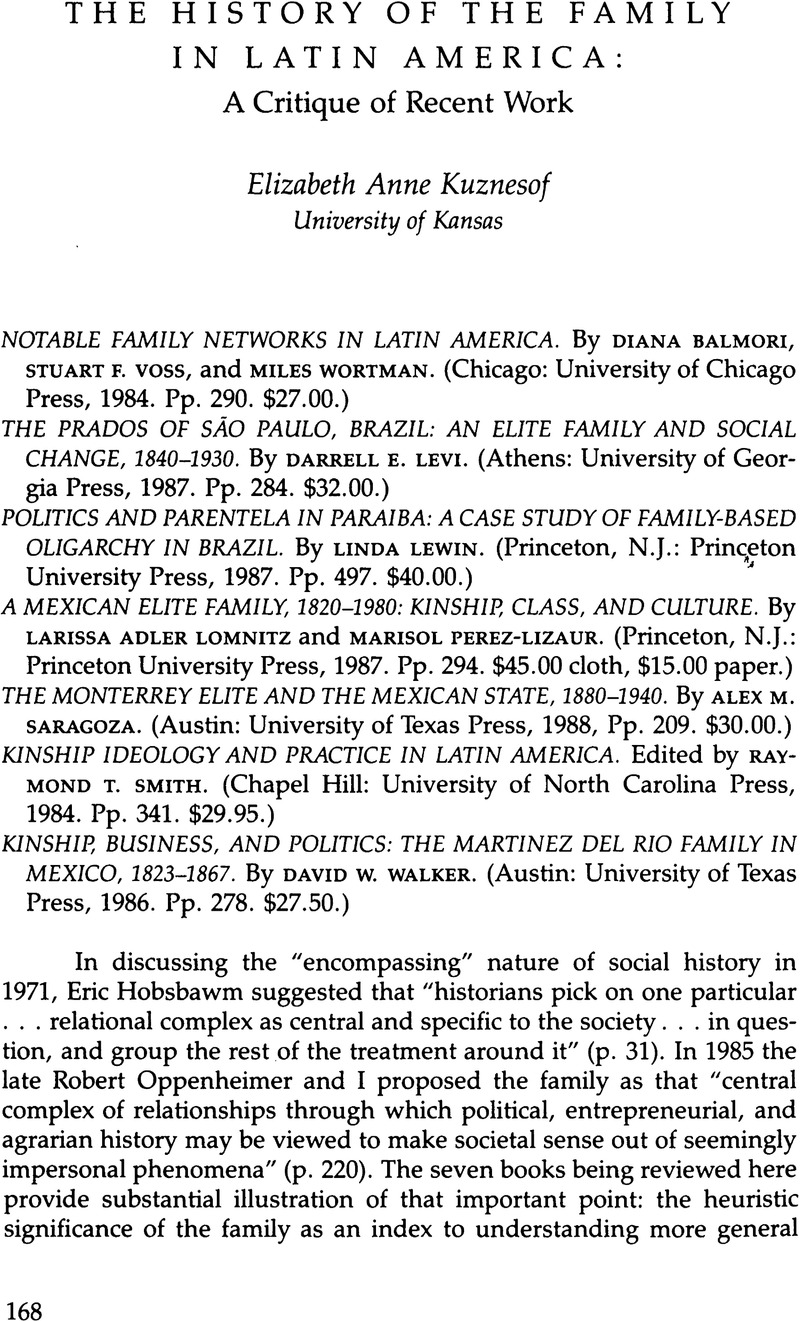Published online by Cambridge University Press: 12 October 2022

1. Raymond T. Smith, “The Family and the Modern World System: Some Observations from the Caribbean,” Journal of Family History 3, no. 4 (1978):351.
2. “Family Clusters: The Generational Nucleation of Families in Nineteenth-Century Argentina and Chile,” Comparative Studies in Society and History 21:231–61.
3. Vítor Nunes Leal, Coronelismo: The Municipality and Representative Government in Brazil (Cambridge: Cambridge University Press, 1977), 1.
4. Ibid., 16.
5. Asunción Lavrin and Edith Couturier, “Dowries and Wills: A View of Women's Socioeconomic Role in Colonial Guadalajara and Puebla, 1640–1790,” Hispanic American Historical Review 59, no. 2 (1979):280–304; Edith Couturier, “Women and the Family in Eighteenth-Century Mexico: Law and Practice,” Journal of Family History 10, no. 3 (1985):294–304; Silvia Arrom, “Changes in Mexican Family Law in the Nineteenth Century,” Journal of Family History 10, no. 3 (1985):305–17; Elizabeth Kuznesof, “Property Law and Family Strategies: Inheritance and Corporations in Brazil, 1800–1960,” paper presented at the American Historical Association meeting, 30 Dec. 1984, Chicago; Elizabeth Kuznesof, Household Economy and Urban Development: São Paulo, 1765 to 1836 (Boulder, Colo.: Westview, 1986), 35–53; and María Beatriz Nizza da Silva, Sistema de Casamento no Brasil Colonial (São Paulo: Editora de Universidade de São Paulo, 1984).
6. Edith Couturier, La hacienda de Hueyapan, 1550–1936 (Mexico City: Instituto Nacional de Antropología e Historia, 1976); Edith Couturier, “Women in a Noble Family: The Mexican Counts of Regla, 1750–1830,” in Latin American Women: Historical Perspectives, edited by Asuncion Lavrin (Westport, Conn.: Greenwood, 1978), 129–49; Asunción Lavrin, “Women in Spanish American Colonial Society,” in Cambridge History of Latin America, 2:321–55 (Cambridge: Cambridge University Press, 1984); Asunción Lavrin, “In Search of the Colonial Woman in Mexico: The Seventeenth and Eighteenth Centuries,” in Lavrin, Latin American Women, 23–59; John Kicza, Colonial Entrepreneurs: Families and Business in Bourbon Mexico City (Albuquerque: University of New Mexico Press, 1983); Florencia E. Mallon, “Gender and Class in the Transition to Capitalism: Household and Mode of Production in Central Peru,” Latin American Perspectives 13 (1986):147–74.
7. Verena Stolcke, “Women's Labours: The Naturalization of Social Inequality and Women's Subordination,” in Of Marriage and the Market: Women's Subordination in International Perspective, edited by Kate Young, Carol Walkowitz, and Roslyn McCullagh (London: CSE Books, 1981), 30–48.
8. Mallon, “Gender and Class,” 149, 153. Also see Donna Guy, “Women, Peonage, and Industrialization: Argentina, 1810–1914,” LAR 16, no. 3 (1981):65–89; and Donna Guy, “Lower-Class Families, Women, and the Law in Nineteenth-Century Argentina,” Journal of Family History 10, no. 3 (1985):318–31.
9. See Alida Metcalf, “Families of Planters, Peasants, and Slaves: Strategies for Survival in Santana de Parnaíba, Brazil, 1720–1820,” Ph.D. diss., University of Texas at Austin, 1983; and Alida Metcalf, “Fathers and Sons: The Politics of Inheritance in a Colonial Brazilian Township,” Hispanic American Historical Review 66, no. 3 (1986):45–84.
10. John Tutino, “Power, Class, and Family: Men and Women in the Mexican Elite, 1750–1810,” Americas 39:359–82.
11. Guy, “Lower-Class Families, Women, and the Law”; and Arrom, “Changes in Mexican Family Law.”
12. Balmori and Oppenheimer, “Family Clusters.”
13. Lavrin and Couturier, “Dowries and Wills”; Couturier, “Women and the Family”; Margaret Chowning, “A Mexican Provincial Elite: Michoacán, 1810–1910,” Ph.D. diss., Stanford University, 1985; and Muriel Nazzari, “Women, the Family, and Property: The Decline of the Dowry in São Paulo, Brazil (1600–1870),” Ph.D. diss., Yale University, 1986.
14. Compare this treatment with Mark Wasserman, Capitalists, Caciques, and Revolution: The Native Elite and Foreign Enterprise in Chihuahua, Mexico, 1854–1911 (Chapel Hill: University of North Carolina Press, 1984).